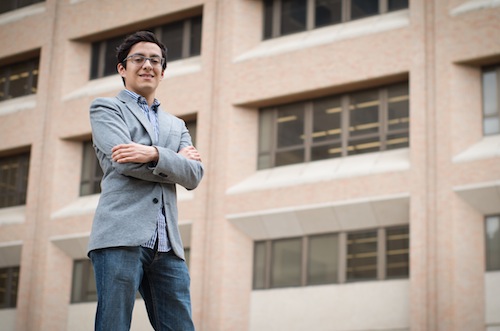 Victor Rodriguez, a fourth year physics and mathematics major, is a 2013 Goldwater Scholar. He grew up in Mexico and moved to El Paso for his junior and senior years of high school. I sat down with Rodriguez to learn more about his two majors and the long list of research accolades he has accumulated, which has taken him across the Atlantic twice now to both Italy and Switzerland.
Victor Rodriguez, a fourth year physics and mathematics major, is a 2013 Goldwater Scholar. He grew up in Mexico and moved to El Paso for his junior and senior years of high school. I sat down with Rodriguez to learn more about his two majors and the long list of research accolades he has accumulated, which has taken him across the Atlantic twice now to both Italy and Switzerland.
Rodriguez: I actually started in aerospace engineering but I found my classes were not exactly what I wanted. I enjoyed knowing the “why” of things more than putting them into practice. My physics and math classes were the most interesting to me so I switched to physics after my freshman year and added math a semester after that.
What do you plan to do after you graduate?
I want to learn more of both math and physics and pursuing a PhD. in either theoretical or experimental physics (I’m not sure which one yet) will certainly allow me to do so.
I have always had an interest in both physics and math but I mostly like math in terms of how it’s used in physics.
So what kind of research have you participated in here at UT?
I try to do some type of research every summer. I did the FRI my first summer with Dr. John Markert on a pulse nuclear magnetic resonance spectroscopy experiment. It was very experimental. Then that fall I joined Dr. Christina Markert’s lab where we learned about heavy ion and high energy physics.
But you also did some research in Europe, correct? Can you tell me about that?
The summer after I first worked with Dr. Markert, I traveled to the Frascati National Laboratory in Italy, where I developed code that tested the proper functioning of high-level trigger algorithms for the reconstruction of particles. Then the next summer I worked at CERN (the European Organization for Nuclear Research) in Geneva, Switzerland for the ATLAS Experiment Collaboration, one of the two main detectors at CERN that are looking for the Higgs boson.
Can you tell me more about working at CERN?
When working with the Higgs boson there are two main detectors and their associated collaborations of scientists. I was working with the ATLAS group. There are many decays into which the Higgs boson can be detected and this is what they separate the collaborations into. If a Higgs boson is produced in a particle collision, we expect, according to the Standard model, that it will decay into one of several possible decay modes. The collaborations assign several subgroups to study one particular decay mode to search for the Higgs. I worked with the subgroup studying the decay H → WW(∗) → lνlν. To test for the presence of the particle they apply these specific cuts to the data and then you can see if there is a signal. I was trying to optimize the value of those cuts so we could see the maximum signal.
So what is the Higgs boson?
So you know how everything is made of atoms? Well we’ve kept looking at them to see if they have further structure. We know there is a nucleus with protons and neutrons, and then electrons surrounding it. But then we discovered that protons and neutrons are made of even smaller particles, which we now call quarks. Along with leptons (like electrons) and the force carriers, quarks are the most fundamental particles that we know of. We also have the four forces: gravity, electromagnetism, the weak force, and the strong force. For example, in a particle collision we can have interactions of particles via any force, except for gravity, which is too weak to affect such energetic collisions. The force carriers are the particles associated with carrying these forces. The physics that describes these fundamental particles and the forces (except gravity) is called the Standard Model, and so far it correctly describes high-energy phenomena. Part of this theory explains how quarks have their masses. It’s sort of like we are living in a field (we call it the Higgs field) that is just there and particles, like quarks, interact with it to get their masses. There is then a particle associated with this field and that is the Higgs boson that you can observe in high-energy collisions like in the Large Hadron Collider at CERN.
Didn’t you attend the press conference where they announced that they found the Higgs boson?
I was able to attend the press conference and it was so much fun. They allowed summer students to go so I was lucky. We got there at 4 a.m. and waited for five hours to get a seat and we were able to get inside for the conference, which was quite an experience.
How do you think UT has helped you on your research journeys?
UT has been terrific. Being here has granted me a lot of opportunities, especially when I started working in the Freshman Research Initiative. FRI led me to Dr. Markert and then she recommended me for the Italy program. The FRI was my springboard.

















Comments